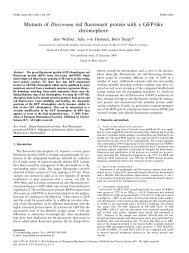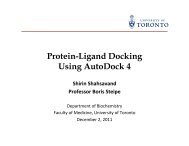An NMR-based Model of the Ubiquitin-bound Human Ubiquitin ...
An NMR-based Model of the Ubiquitin-bound Human Ubiquitin ...
An NMR-based Model of the Ubiquitin-bound Human Ubiquitin ...
Create successful ePaper yourself
Turn your PDF publications into a flip-book with our unique Google optimized e-Paper software.
13152The Structural Basis for Lysine 63 Chain Catalysistein-protein interactions within <strong>the</strong> Ub-<strong>bound</strong> complex (27).Using <strong>the</strong> previously determined assignments for Ub in 1 H- 15 NHSQC <strong>NMR</strong> experiments, we were able to footprint <strong>the</strong> surface<strong>of</strong> Ub that interacted with <strong>the</strong> human hUbc13hMms2 heterodimerand each <strong>of</strong> its subunits in ei<strong>the</strong>r <strong>the</strong> thiolester-linkedor unlinked forms (27). The results <strong>of</strong> this study were consistentwith a two-binding site model in which an “acceptor” molecule<strong>of</strong> Ub <strong>bound</strong> non-covalently to hMms2 was positioned inan orientation such that a second Ub molecule that was linkedto hUbc13 as a thiolester could be transferred to Lys-63 <strong>of</strong> <strong>the</strong>accepting Ub molecule. The <strong>NMR</strong> assignments <strong>of</strong> both hMms2and hUbc13 is an obvious prerequisite for footprinting <strong>the</strong>surfaces <strong>of</strong> <strong>the</strong> heterodimer that interact with both <strong>the</strong> covalentlylinked and unlinked forms <strong>of</strong> Ub. In <strong>the</strong> present workwe have determined <strong>the</strong> footprint that both Ub molecules makeon <strong>the</strong> surface <strong>of</strong> <strong>the</strong> hUbc13hMms2 heterodimer. Taken toge<strong>the</strong>rwith our previous work, a compelling model is presentedfor <strong>the</strong> tetrameric structure that places Lys-63 <strong>of</strong> <strong>the</strong> acceptingUb molecule in catalytic proximity <strong>of</strong> <strong>the</strong> C terminus <strong>of</strong> <strong>the</strong>donor Ub molecule.EXPERIMENTAL PROCEDURESProtein Expression—hUbc13 and hMms2 were expressed and purifiedas described previously (27) with <strong>the</strong> following exceptions. Proteinswere expressed in <strong>the</strong> Escherichia coli strain BL21(DE3)-RP (Stratagene),and 2-liter cultures were grown at 25 °C to A 590 0.3 inminimal media containing 15 NH 4 Cl as <strong>the</strong> sole nitrogen source andinduced with isopropyl--D-thiogalactopyranoside (0.4 mM) for an additional24 h at 25 °C. S. cerevisiae UbK48R, UbK63R, and Uba1 (E1)were expressed and purified as described previously (27).<strong>NMR</strong> Spectroscopy—All <strong>NMR</strong> spectra were obtained using a VarianUnity INOVA 600-MHz spectrometer at 30 °C. The two-dimensional1 H- 15 N-HSQC <strong>NMR</strong> spectra were acquired using <strong>the</strong> sensitivity-enhancedgradient pulse scheme developed by Kay and co-workers (28,29). The 1 H and 15 N sweep widths were 8000 and 2200 Hz, respectively.A minimum <strong>of</strong> 64 transients was collected for each spectrum. All <strong>NMR</strong>samples were prepared to include HEPES (50 mM, pH 7.5), NaCl (75mM), EDTA (1 mM), dithiothreitol (1 mM), and 2,2-dimethyl-2-silapentane-5-sulfonate(1 mM) in <strong>the</strong> presence <strong>of</strong> 9:1 H 2 O:D 2 O.Spectral processing was accomplished with <strong>the</strong> <strong>NMR</strong>Pipe program(30). The <strong>NMR</strong>view program (31) was employed in <strong>the</strong> assignment <strong>of</strong> alltwo-dimensional 1 H- 15 N-HSQC <strong>NMR</strong> cross-peaks. To calculate <strong>the</strong> totalaverage change in backbone amide 1 H N and 15 N chemical shifts for eachresonance, <strong>the</strong> following equation was applied (32), total 15 N 2 1 HN 2 (Eq. 1)where 15 N and 1 H are <strong>the</strong> chemical shift changes in hertz. Theaverage change in total chemical shift was <strong>the</strong>n calculated for eachidentified residue, with <strong>the</strong> exception <strong>of</strong> those whose resonances hadbroadened past detectability in <strong>the</strong> two-dimensional 1 H- 15 N-HSQC<strong>NMR</strong> spectra. The standard deviation associated with each dataset wasalso calculated.15 N-hMms2 Chemical Shift Perturbation Experiments—<strong>An</strong> initialtwo-dimensional 1 H- 15 N-HSQC spectrum was acquired for 15 N-hMms2(250 M) as a point <strong>of</strong> reference for subsequent chemical shift perturbationexperiments. The spectrum also served to confirm <strong>the</strong> properfolding and lack <strong>of</strong> aggregation <strong>of</strong> 15 N-hMms2.The interactions between 15 N-hMms2 and hUbc13 were examined byinclusion <strong>of</strong> a slight excess <strong>of</strong> unlabeled hUbc13 (300 M) to <strong>the</strong> sampledescribed above for 15 N-hMms2 alone. The <strong>NMR</strong> tube was allowed toequilibrate for 1hat30°C to ensure heterodimerization would proceedto completion. A two-dimensional 1 H- 15 N-HSQC spectrum was <strong>the</strong>nacquired for <strong>the</strong> sample.Non-covalent interactions between 15 N-hMms2 (250 M) and Ubwere examined by including unlabeled UbK48R (600 M) into <strong>NMR</strong>samples in <strong>the</strong> presence or absence <strong>of</strong> unlabeled hUbc13 (300 M). Atwo-dimensional 1 H- 15 N-HSQC spectrum was <strong>the</strong>n acquired for eachsample. Chemical shift assignments in <strong>the</strong> two-dimensional 1 H- 15 N-HSQC spectra were again completed assuming that <strong>the</strong> closest crosspeakrepresented <strong>the</strong> correct change in chemical shift. The two-dimensional1 H- 15 N-HSQC <strong>NMR</strong> reference spectrum used when calculatingchanges caused by Ub were ei<strong>the</strong>r (i) 15 N-hMms2 alone to examine <strong>the</strong>changes cause in hMms2 by itself or (ii) 15 N-hMms2hUbc13 to probe <strong>the</strong>changes in chemical shift in hMms2 in <strong>the</strong> context <strong>of</strong> <strong>the</strong> heterodimer.15 N-hUbc13 Chemical Shift Perturbation Experiments—As in <strong>the</strong>case <strong>of</strong> hMms2, an initial two-dimensional 1 H- 15 N-HSQC <strong>NMR</strong> spectrumwas acquired as a point <strong>of</strong> reference and confirmed <strong>the</strong> properfolding and lack <strong>of</strong> aggregation <strong>of</strong> 15 N-hUbc13 (305 M).The interactions between 15 N-hUbc13 and hMms2 were examined byinclusion <strong>of</strong> a slight excess <strong>of</strong> unlabeled hMms2 (330 M) to <strong>the</strong> sampledescribed above for 15 N-hUbc13 alone. Sample equilibration and acquisitionwere performed as described for <strong>the</strong> 15 N-hMms2 samples.Thiolester-linked interactions between 15 N-hUbc13 (305 M) and Ub(330 M) were examined in situ by inclusion <strong>of</strong> S. cerevisiae E1 (0.3 M),ATP (5 mM), and MgCl 2 (5 mM) as described previously (27). Addition <strong>of</strong>hMms2 (330 M) to this sample allowed for <strong>the</strong> examination <strong>of</strong> <strong>the</strong>hMms2 15 N-hUbc13-Ub species. Studies described elsewhere (27) haveshown that thiolester formation is rapid (minutes) whereas <strong>the</strong> formation<strong>of</strong> Ub conjugate on hUbc13 is slow (hours). Fur<strong>the</strong>rmore, <strong>the</strong> onset<strong>of</strong> conjugate formation can be clearly identified <strong>based</strong> on <strong>the</strong> accumulation<strong>of</strong> new peaks emanating from <strong>the</strong> mixed population <strong>of</strong> Ub species.The two-dimensional 1 H- 15 N-HSQC <strong>NMR</strong> experiments were <strong>the</strong>reforeperformed between 10 and 120 min after <strong>the</strong> addition <strong>of</strong> E1 to minimize<strong>the</strong> impact <strong>of</strong> possible side-reactions. UbK63R was employed as <strong>the</strong>Ub species to eliminate <strong>the</strong> possibility <strong>of</strong> chain formation by <strong>the</strong>hUbc13hMms2 heterodimer and, hence, to eliminate fur<strong>the</strong>r complication<strong>of</strong> <strong>the</strong> spectra (27). The two-dimensional 1 H- 15 N-HSQC <strong>NMR</strong> referencespectra used when calculating changes caused by Ub in thiolestercomplexes were ei<strong>the</strong>r (i) 15 N-hUbc13 alone to examine <strong>the</strong> changescaused in hUbc13 by itself or (ii) 15 N-hUbc13hMms2 to probe <strong>the</strong> changesin chemical shift in hUbc13 in <strong>the</strong> context <strong>of</strong> <strong>the</strong> heterodimer.Non-covalent interactions between 15 N-hUbc13 and Ub were detectedby including unlabeled UbK63R into <strong>NMR</strong> samples in <strong>the</strong> presenceor absence <strong>of</strong> unlabeled hUbc13 under conditions identical tothiolester formation with <strong>the</strong> exception that E1, ATP, and MgCl 2 wereomitted. A two-dimensional 1 H- 15 N-HSQC <strong>NMR</strong> spectrum was <strong>the</strong>nacquired for each sample. However, no changes in 15 N-hUbc13 crosspeakswere observed in ei<strong>the</strong>r case, and <strong>the</strong>refore no fur<strong>the</strong>r analysiswas performed.Molecular <strong>Model</strong>ing—Molecular modeling <strong>of</strong> <strong>the</strong> surfaces <strong>of</strong> interactionwas accomplished using <strong>the</strong> BiGGER s<strong>of</strong>t-docking algorithm(33, 34) using <strong>the</strong> un<strong>bound</strong> structures <strong>of</strong> Ub (target) (35) and <strong>the</strong>hUbc13hMms2 heterodimer (probe) (26). The BiGGER algorithm systematicallysearches <strong>the</strong> complete six-dimensional binding spaces <strong>of</strong>both target and probe and <strong>the</strong>n evaluates <strong>the</strong>se solutions in terms <strong>of</strong> aglobal scoring function consisting <strong>of</strong> geometric complementarity, electrostaticinteractions, desolvation energy, and <strong>the</strong> pairwise propensities<strong>of</strong> amino acid side chains to interact across molecular interfaces. Dockingparameters in this initial search included a 15° angular step, 5000maximum solutions, and 300 minimum atomic contacts. The top 5000solutions <strong>based</strong> on global score were <strong>the</strong>n filtered using <strong>the</strong> <strong>NMR</strong>chemical shift perturbation data in <strong>the</strong> following manner. First, surface-exposedresidues on hMms2 and Ub, respectively, which producedsignificant total values upon non-covalent interaction were determined,and <strong>the</strong> number <strong>of</strong> atomic contacts between <strong>the</strong>se two groupswithin a 5-Å distance cut<strong>of</strong>f in each <strong>of</strong> <strong>the</strong> top 5000 solutions as determinedby global score was evaluated. The top solution <strong>based</strong> on <strong>the</strong>secriteria was <strong>the</strong>n accepted as <strong>the</strong> “correct” orientation and subsequentlyunderwent minimization using <strong>the</strong> INSIGHTII suite <strong>of</strong> programs. Thethiolester-<strong>bound</strong> Ub placement upon <strong>the</strong> heterodimer was <strong>the</strong>n determinedin an identical manner using total values.RESULTSWhen engaged in catalysis, <strong>the</strong> hUbc13hMms2 heterodimernecessarily exists as part <strong>of</strong> a tetramer that is composed <strong>of</strong> <strong>the</strong>heterodimer in association with two Ub molecules. One Ubmolecule is linked as a thiolester to <strong>the</strong> active site <strong>of</strong> hUbc13(<strong>the</strong> donor) while <strong>the</strong> o<strong>the</strong>r Ub molecule interacts non-covalentlywith hMms2 (<strong>the</strong> acceptor). Although a high resolutioncrystallographic structure for <strong>the</strong> heterodimer has been determined(26), a crystallographic structure for <strong>the</strong> Ub-<strong>bound</strong> tetrameris unlikely. This conclusion is <strong>based</strong> both on <strong>the</strong> instability<strong>of</strong> <strong>the</strong> hUbc13-Ub thiolester bond (36) and <strong>the</strong> relativelyweak interaction that exists between <strong>the</strong> acceptor Ub andhMms2 (K d 100 M). 2 Based on <strong>the</strong>se considerations, we havepursued an alternative <strong>NMR</strong>-<strong>based</strong> approach to determine <strong>the</strong>2 S. McKenna, J. Hu, T. Moraes, W. Xiao, L. Spyracopoulos, and M. J.Ellison, manuscript in preparation.Downloaded from www.jbc.org at University <strong>of</strong> British Columbia on February 18, 2009







